Abstract
OBJECTIVES: In the 1990s, U.S. cancer mortality rates declined due to reductions in tobacco use among men and beneficial cancer interventions, such as mammography and Pap smears. We examined the cancer rates by racial/ethnic group, socioeconomic status and time period to identify disparities underlying the overall mortality trend. METHODS: We examined racial/ethnic disparities by measuring excess cancer burden [rate ratio (RR) and ratio differences (RD)] and trends in their cancer rates for nine cancer sites. The trend (T) is calculated as a ratio of the average annual cancer mortality rate for 1995-2000 relative to the rate for 1990-1994 for three levels of poverty (counties with <10% living below the poverty level, 10% - <20% and > or =20%) for the major racial/ethnic populations. We also compared the trend for each racial/ethnic SES group to the trend for lowest SES white group (TD). RESULTS: Blacks have RR disparities relative to whites for each cancer site examined, except for female lung cancer, while the other minorities had RR disparities for cervical cancer (RR>1). There are increases in RR disparities from 1990-1994 to 1995-2000 (RD>0) for colorectal cancer, prostate cancer and breast cancer for each racial/ethnic minority. Whites and blacks had declining trends for every SES group (T<1) and positive high SES gradients (the highest SES group had the best trend and the lowest SES group had the worst trend) at each cancer site, except female lung cancer (T>1). In contrast, American Indians/Alaska natives, Hispanics and Asians/ Pacific Islanders had increasing trends for some of their cancer sites, and their trends did not have the SES gradients. CONCLUSIONS: Increases in racial/ethnic disparities (RD>0) for colorectal, breast and prostate cancer were largest in the lowest SES groups. At some cancer sites, the highest SES group for minorities had worse trend results than the trends for the lowest SES white group (TD>0).
Full text
PDF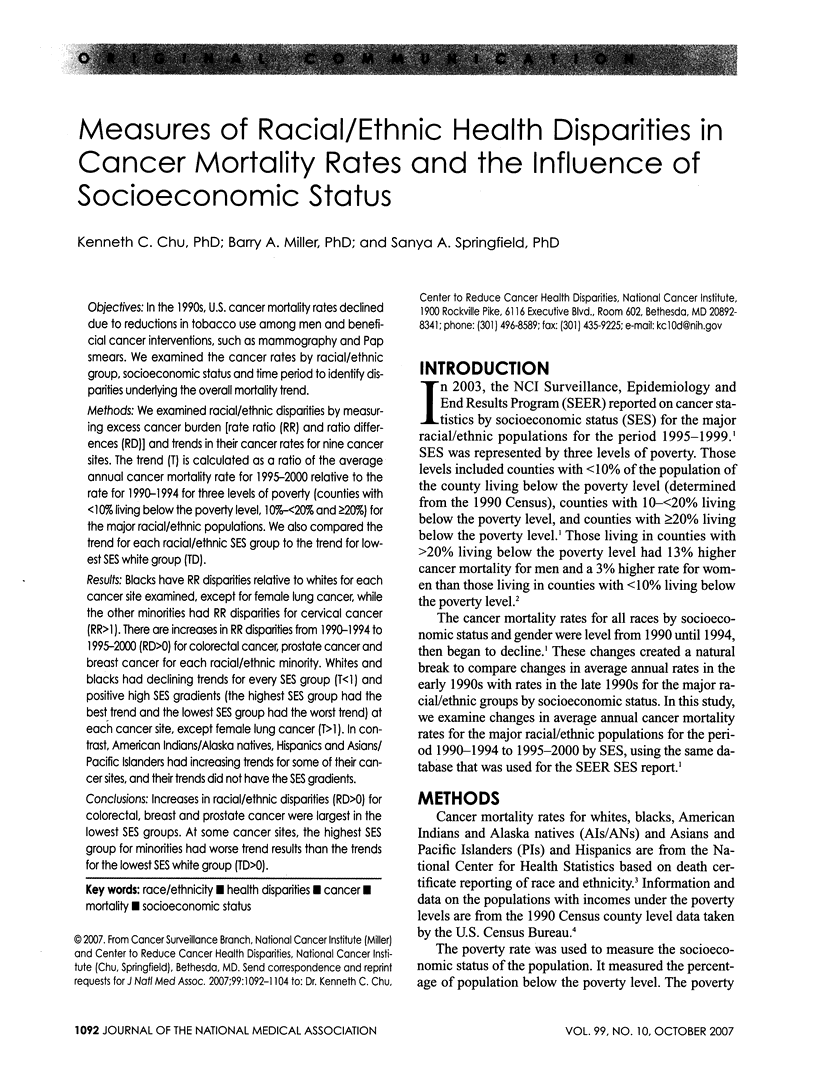
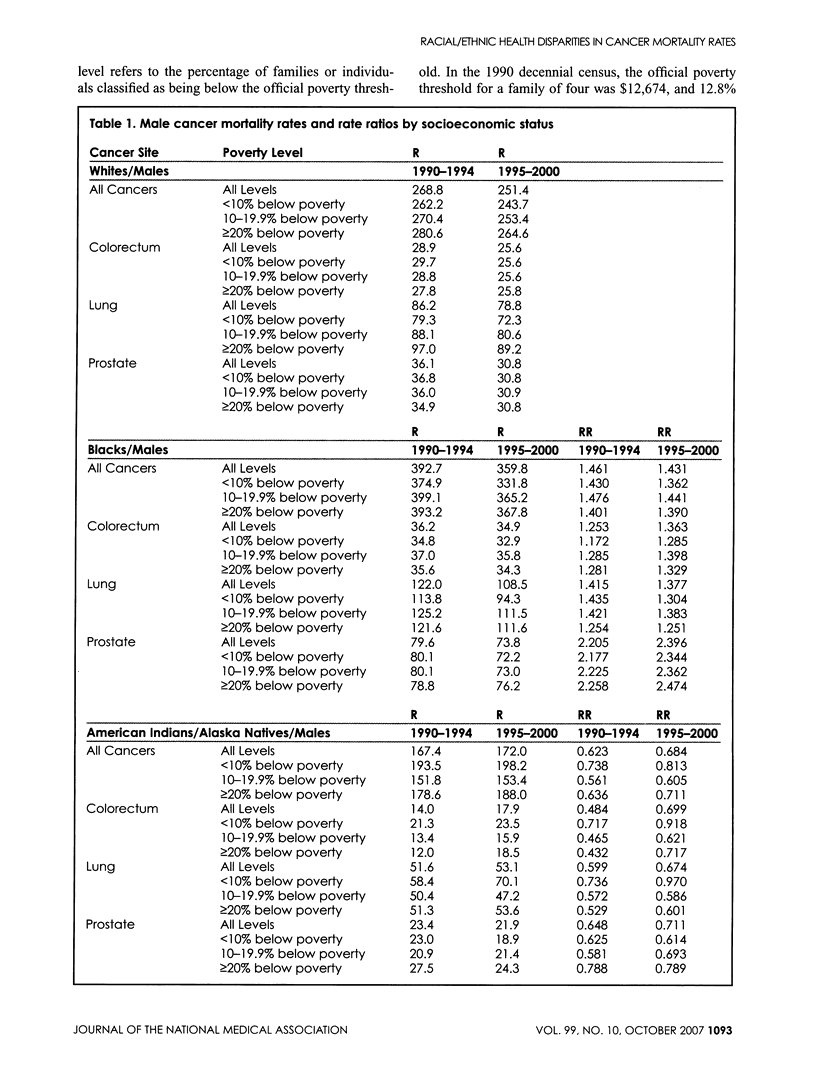
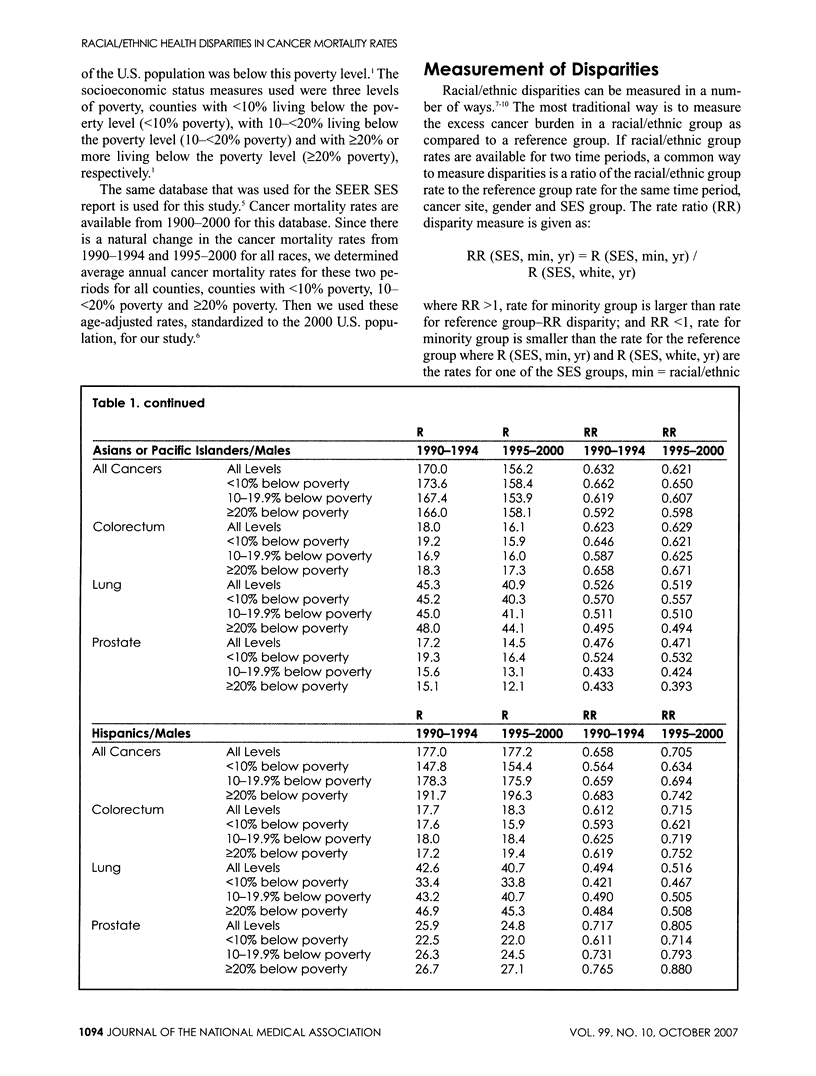
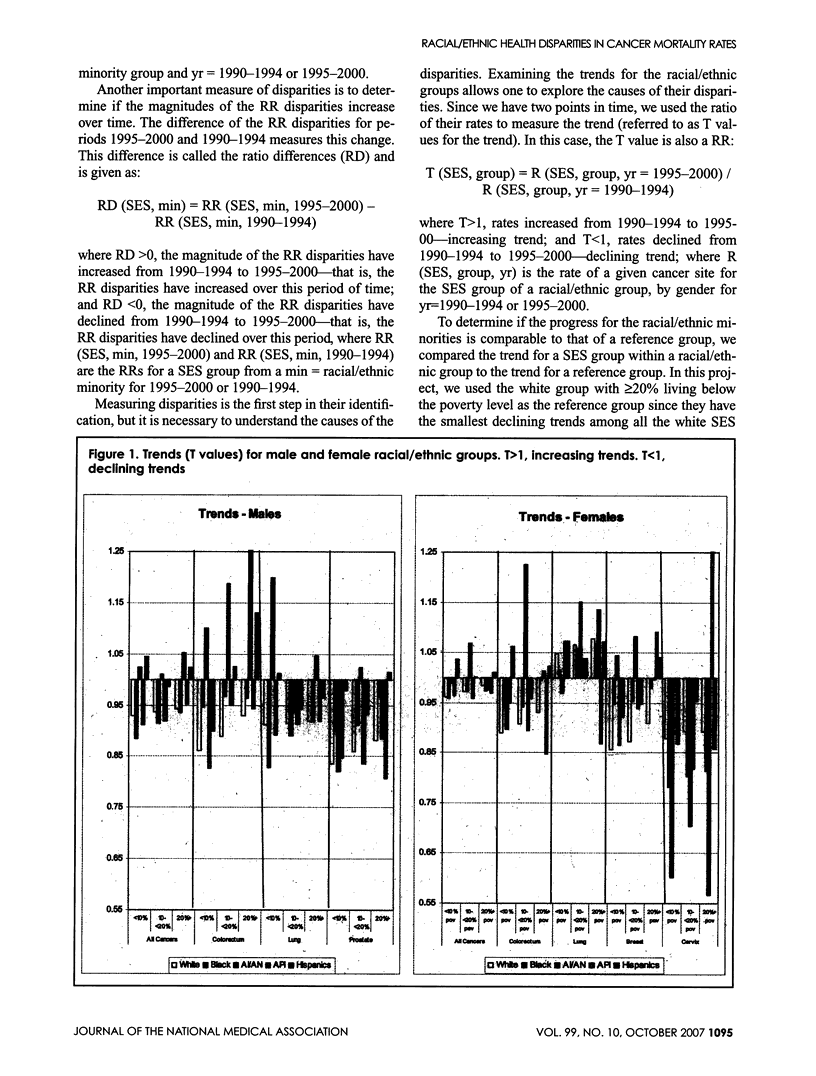
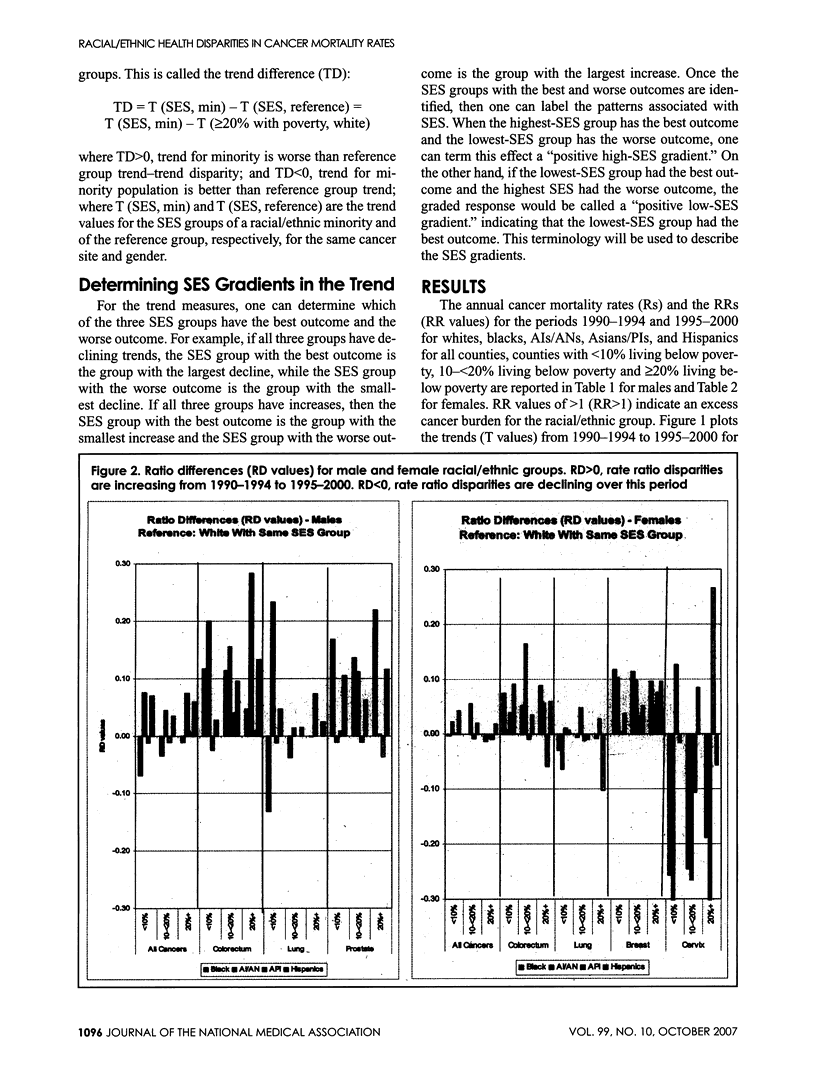
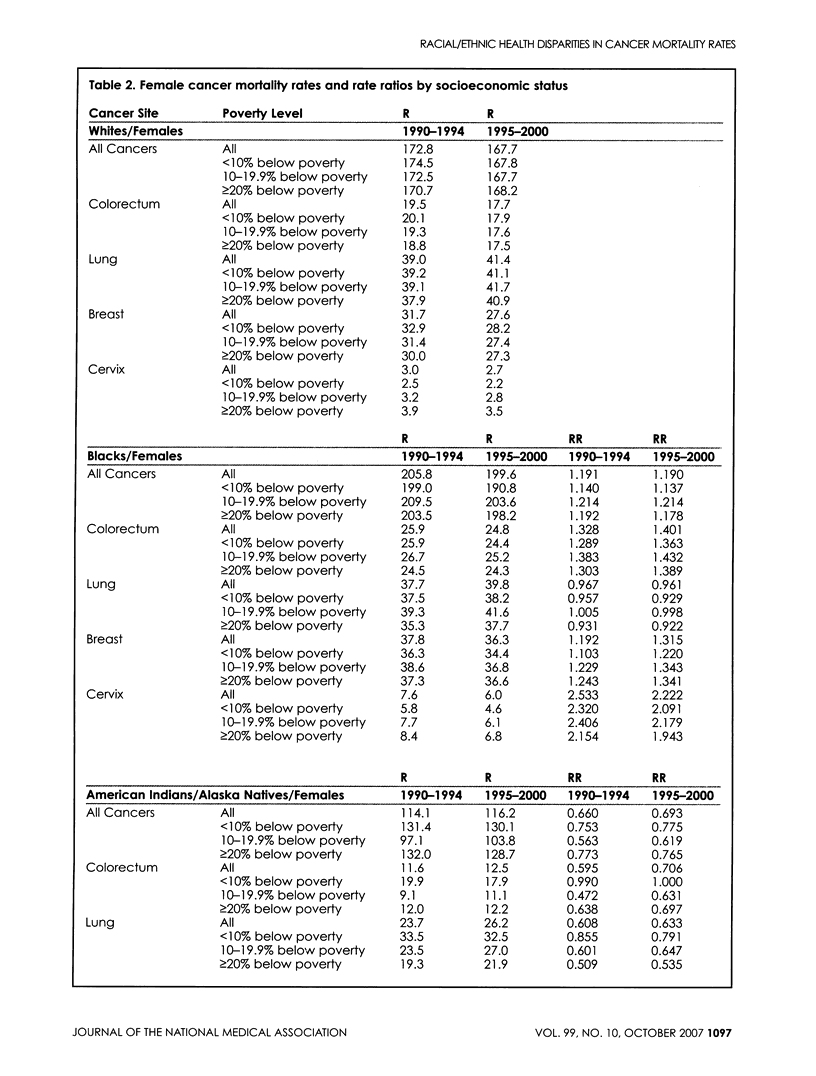
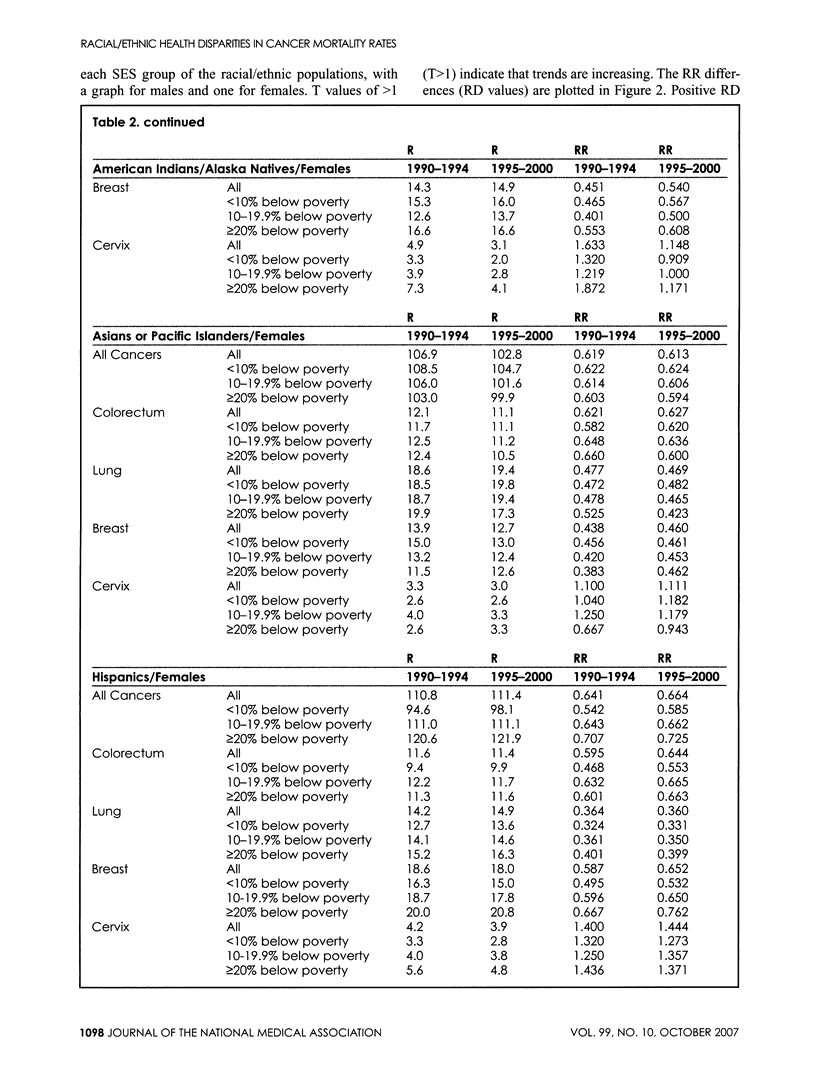
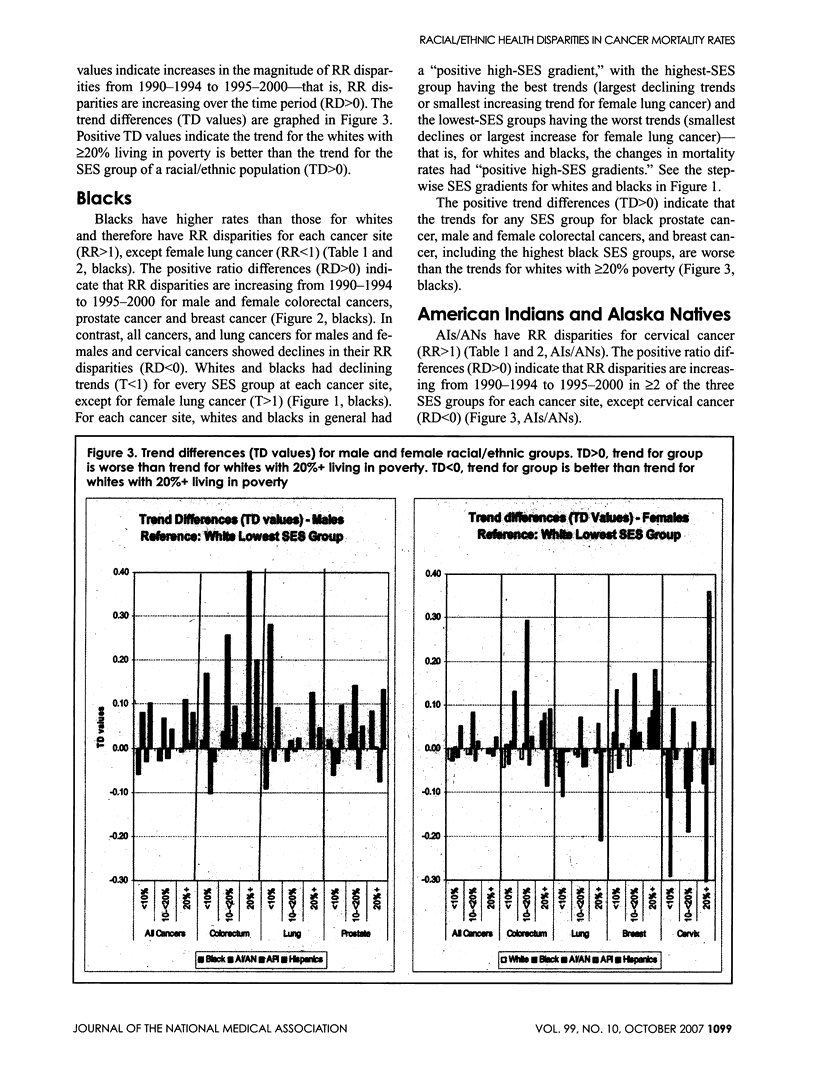
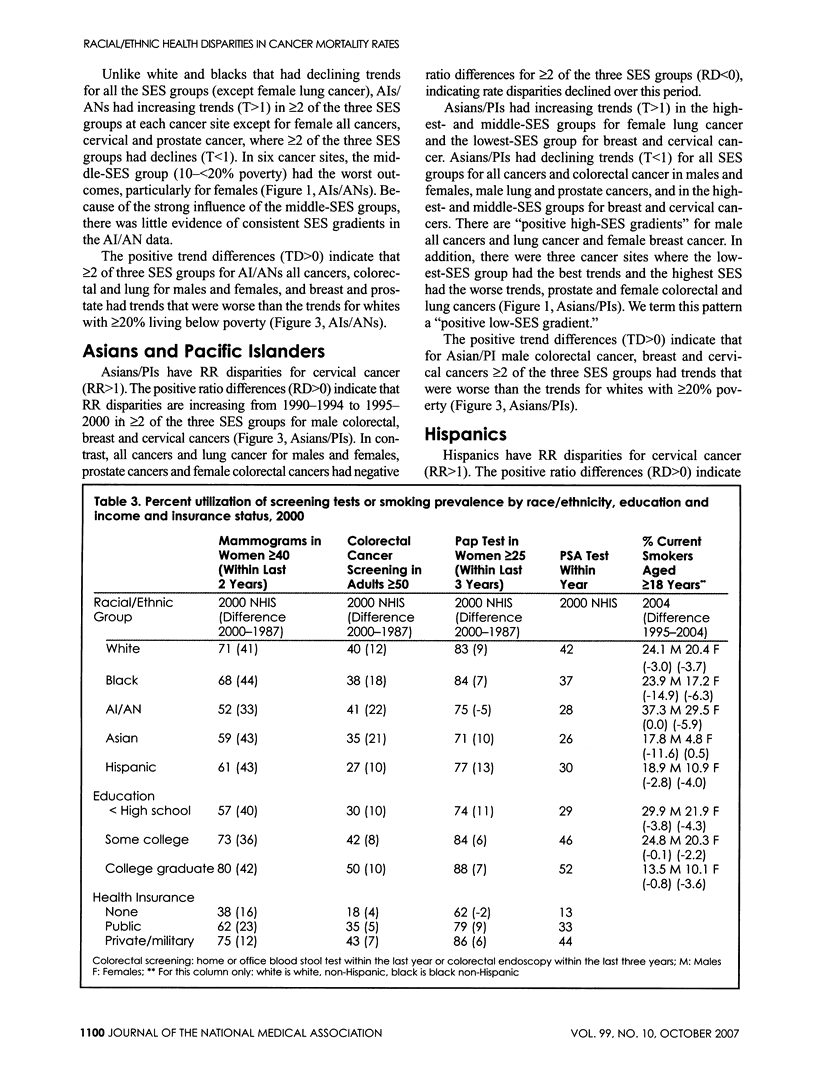
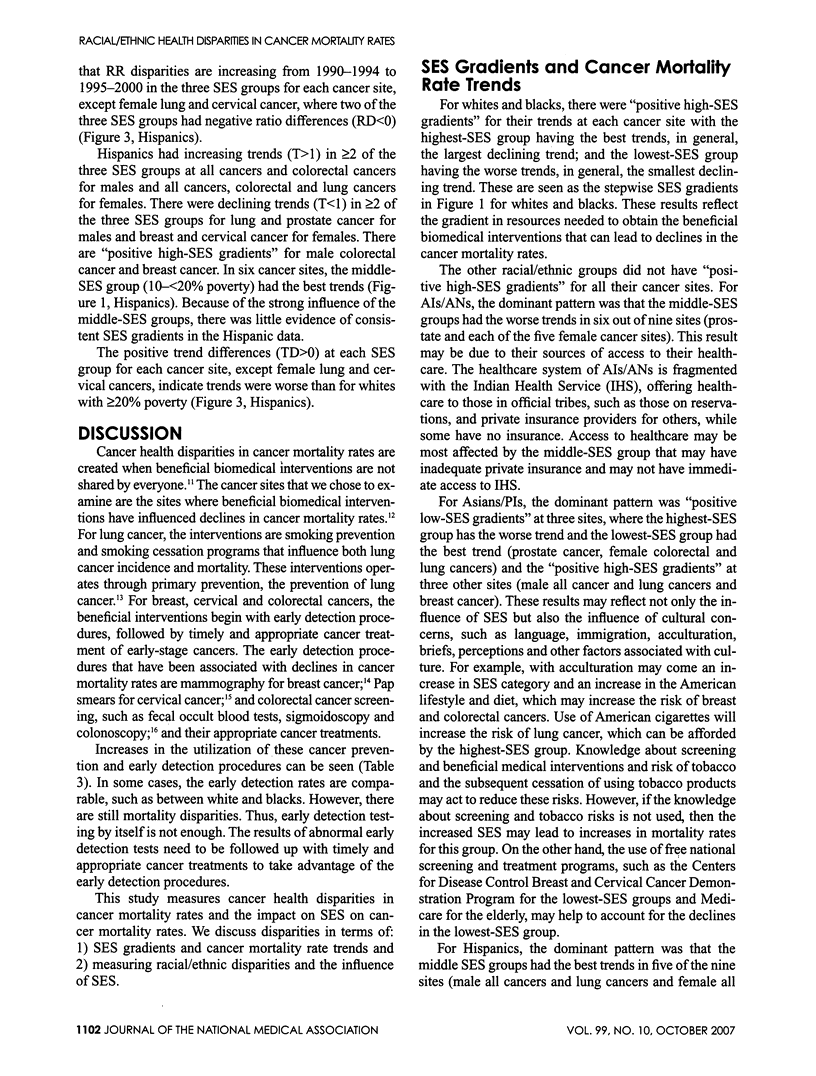
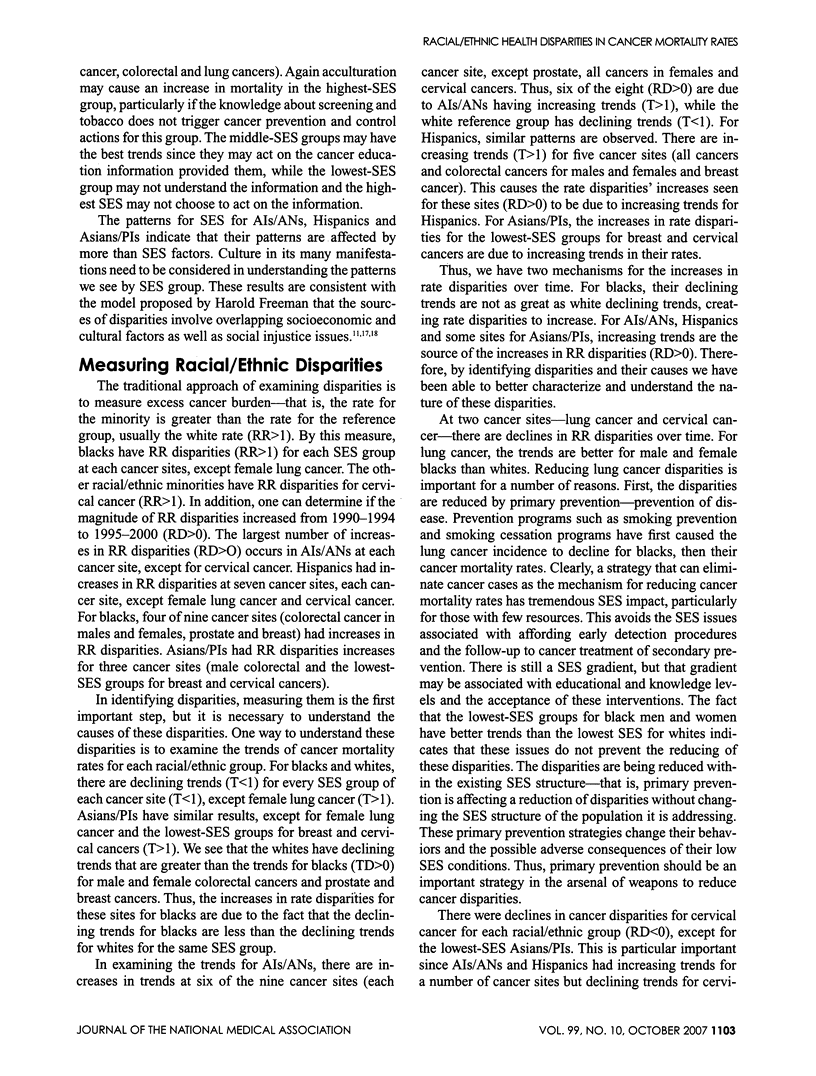
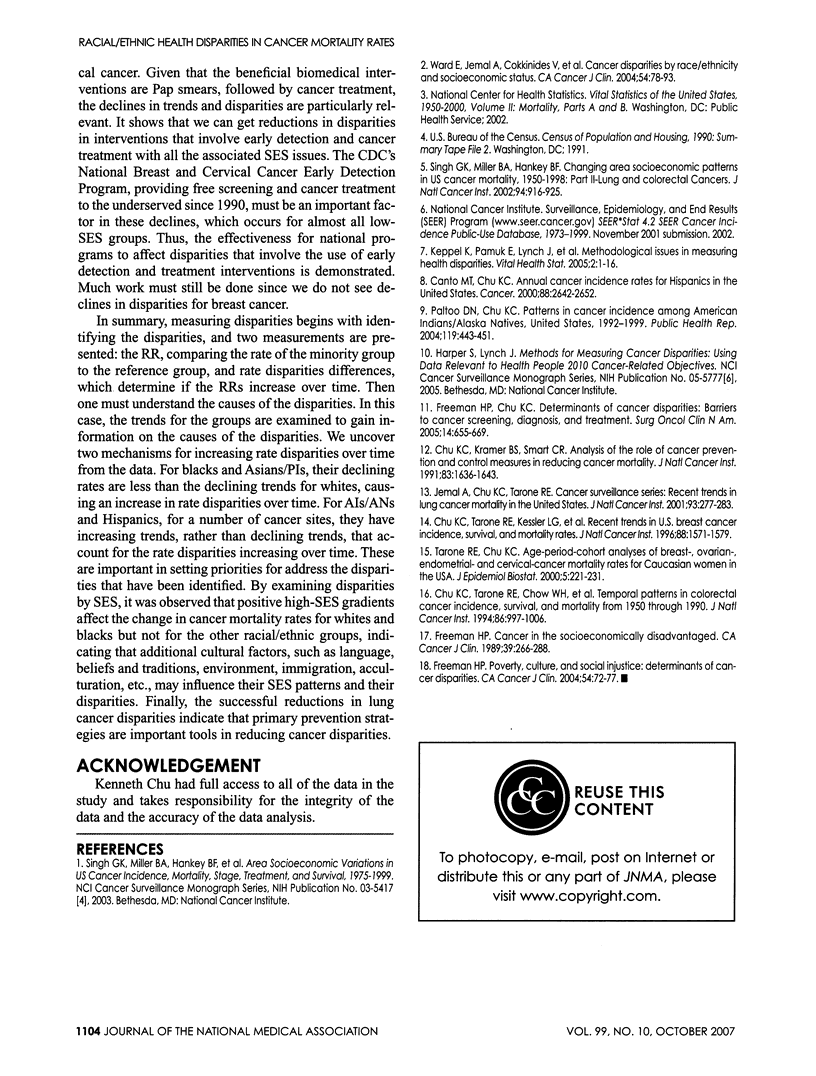
Selected References
These references are in PubMed. This may not be the complete list of references from this article.
- Canto M. T., Chu K. C. Annual cancer incidence rates for Hispanics in the United States: surveillance, epidemiology, and end results, 1992-1996. Cancer. 2000 Jun 1;88(11):2642–2652. doi: 10.1002/1097-0142(20000601)88:11<2642::aid-cncr29>3.0.co;2-s. [DOI] [PubMed] [Google Scholar]
- Chu K. C., Kramer B. S., Smart C. R. Analysis of the role of cancer prevention and control measures in reducing cancer mortality. J Natl Cancer Inst. 1991 Nov 20;83(22):1636–1643. doi: 10.1093/jnci/83.22.1636. [DOI] [PubMed] [Google Scholar]
- Chu K. C., Tarone R. E., Chow W. H., Hankey B. F., Ries L. A. Temporal patterns in colorectal cancer incidence, survival, and mortality from 1950 through 1990. J Natl Cancer Inst. 1994 Jul 6;86(13):997–1006. doi: 10.1093/jnci/86.13.997. [DOI] [PubMed] [Google Scholar]
- Chu K. C., Tarone R. E., Kessler L. G., Ries L. A., Hankey B. F., Miller B. A., Edwards B. K. Recent trends in U.S. breast cancer incidence, survival, and mortality rates. J Natl Cancer Inst. 1996 Nov 6;88(21):1571–1579. doi: 10.1093/jnci/88.21.1571. [DOI] [PubMed] [Google Scholar]
- Freeman H. P. Cancer in the socioeconomically disadvantaged. CA Cancer J Clin. 1989 Sep-Oct;39(5):266–288. doi: 10.3322/canjclin.39.5.266. [DOI] [PubMed] [Google Scholar]
- Freeman Harold P., Chu Kenneth C. Determinants of cancer disparities: barriers to cancer screening, diagnosis, and treatment. Surg Oncol Clin N Am. 2005 Oct;14(4):655-69, v. doi: 10.1016/j.soc.2005.06.002. [DOI] [PubMed] [Google Scholar]
- Freeman Harold P. Poverty, culture, and social injustice: determinants of cancer disparities. CA Cancer J Clin. 2004 Mar-Apr;54(2):72–77. doi: 10.3322/canjclin.54.2.72. [DOI] [PubMed] [Google Scholar]
- Jemal A., Chu K. C., Tarone R. E. Recent trends in lung cancer mortality in the United States. J Natl Cancer Inst. 2001 Feb 21;93(4):277–283. doi: 10.1093/jnci/93.4.277. [DOI] [PubMed] [Google Scholar]
- Keppel Kenneth, Pamuk Elsie, Lynch John, Carter-Pokras Olivia, Kim Insun, Mays Vickie, Pearcy Jeffrey, Schoenbach Victor, Weissman Joel S. Methodological issues in measuring health disparities. Vital Health Stat 2. 2005 Jul;(141):1–16. [PMC free article] [PubMed] [Google Scholar]
- Paltoo Dina N., Chu Kenneth C. Patterns in cancer incidence among American Indians/Alaska Natives, United States, 1992-1999. Public Health Rep. 2004 Jul-Aug;119(4):443–451. doi: 10.1016/j.phr.2004.05.009. [DOI] [PMC free article] [PubMed] [Google Scholar]
- Singh Gopal K., Miller Barry A., Hankey Benjamin F. Changing area socioeconomic patterns in U.S. cancer mortality, 1950-1998: Part II--Lung and colorectal cancers. J Natl Cancer Inst. 2002 Jun 19;94(12):916–925. doi: 10.1093/jnci/94.12.916. [DOI] [PubMed] [Google Scholar]
- Tarone R. E., Chu K. C. Age-period-cohort analyses of breast-, ovarian-, endometrial- and cervical-cancer mortality rates for Caucasian women in the USA. J Epidemiol Biostat. 2000;5(4):221–231. [PubMed] [Google Scholar]
- Ward Elizabeth, Jemal Ahmedin, Cokkinides Vilma, Singh Gopal K., Cardinez Cheryll, Ghafoor Asma, Thun Michael. Cancer disparities by race/ethnicity and socioeconomic status. CA Cancer J Clin. 2004 Mar-Apr;54(2):78–93. doi: 10.3322/canjclin.54.2.78. [DOI] [PubMed] [Google Scholar]


